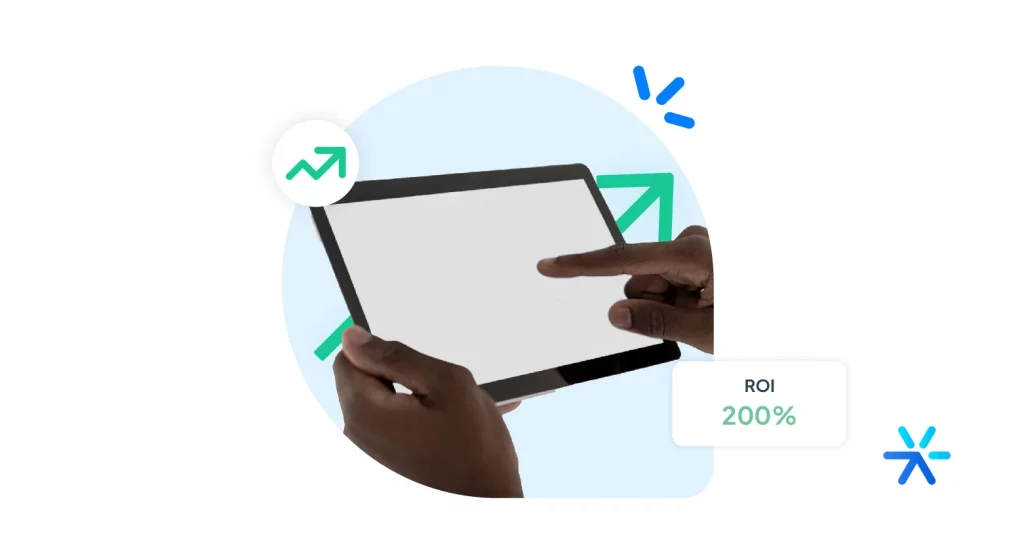Digital Transformation: What it Is and the 5 Basic Pillars
Digital Transformation is a lot of different things. Is it a necessity? Since the 2000s, definitely. Is it a differentiator? In some businesses, yes, in others, it’s simply necessary and expected.
And this also translates into your own application. Is it using an ERP? Is it customer service via WhatsApp? Is it having marketing automation strategies? All of that and then some.
Digital Transformation is broad, restricted, complex, simple: it varies for each business, but it carries some common points within.
Do we start the article with this paradox? 😅 Yes, but it’s a necessary paradox. Before we start our discussion, I need you to understand that Digital Transformation is a very broad subject.
It involves various different fronts, ranging from the adoption of new technologies to the inauguration of new operational practices.
We will address all these points throughout the article today. Let’s get started:
What is Digital Transformation?

The definition of Digital Transformation is simple: through technology, altering the business in visible or even invisible ways to your customer. It is making your company more connected and integrated with itself and with the world around it.
Ultimately, the work of Digital Transformation is closely linked to generating value for your customer. And of course: to reducing costs — both in money and time — for your company.
There are some general tools that are usually associated with Digital Transformation. The use of Digital Marketing, for example, is the clearest and most recognized transformation in the market.
But it doesn’t stop there. Digital Transformation can happen (and does) at various different levels. For example:
- The creation of a delivery app in a restaurant;
- The use of chatbots on your website to generate more leads;
- Customer service through Telegram or WhatsApp chatbots;
- Automation of support processes via chatbot service;
- The use of Business Intelligence apps for decision-making;
- Monitoring website visits via Google Analytics;
- Among several other points related to the main objectives of Digital Transformation. In fact, to better understand what it really is — and this time without paradoxes! — we need to discuss a little more precisely about these objectives.
What Are the Main Objectives of Digital Transformation?

The primary goal of Digital Transformation in any business is efficiency.
But understanding efficiency within this transformative context isn’t that easy. It’s also essential to understand exactly where this efficiency will operate.
That’s why it’s worth understanding the objectives of Digital Transformation before we discuss its application and the steps to make it happen in any type of business.
These objectives provide a much broader overview of what Digital Transformation really is. They also provide the justification for applying it to your company.
Ultimately, the objectives of Digital Transformation are the objectives of any business. They don’t differ much from the basic principles that guide your success.
The biggest difference, however, lies in the means to achieve these goals — all of which involve technology in one way or another.
Let’s now explore the four main objectives of Digital Transformation, according to the primary goals of any company:
Increased Productivity
In Digital Transformation, some points are quite obvious to customers, while others are not, but still make a difference.
For example, using a system to achieve omnichannelity — or selling through all available channels — and allowing the customer to choose to buy online and pick up the product in-store.
But at the same time, there are other transformations happening behind the scenes that also contribute, albeit not visibly, to the customer experience.
Another example: this omnichannelity wouldn’t be possible without inventory management software and other resources — also known as ERPs.
Productivity is one of those behind-the-scenes issues that have significant impacts on the customer’s daily life.
There are various technological solutions that focus on productivity. Some of them include:
- Communication software;
- Advanced email tools;
- ERPs;
- Sales CRMs;
- Work organization apps;
- Accounting organization apps;
- Among several others. Anything that improves work routines is a Digital Transformation focused on productivity.
But now let’s talk about who deserves more attention:
Enhanced Customer Experience
Reducing the wait time for customers to purchase. Making the experience simple and obstacle-free. Facilitating sales to the fullest extent: all of this has the same name: Digital Transformation focused on the customer experience.
This transformation is happening faster today, largely due to pressure from the markets in which companies operate.
For example, 10 years ago, delivery apps didn’t even exist. To order a pizza, you had to call the pizzeria, can you believe it? 😅
But with apps arriving, those who didn’t enter simply lost their delivery market and went out of business.
The targets now include supermarkets with self-checkouts: those who don’t offer automatic checkout kiosks end up offering less than their competitors.
The customer experience can always be improved. And when this change is made through technology, Digital Transformation happens.
Cost Reduction
Cost reduction is also a major concern of Digital Transformation. Operational costs are reduced when you begin to integrate technology into your routines.
Several solutions apply here. Process automation, time measurement in each task, and even the definition of well-formalized spending goals are also facets of Digital Transformation.
With the right tools, it’s possible (and even quite easy) to measure micro and macro aspects of your business, identifying where cost reduction can occur.
And beyond this more active approach, it’s also entirely expected that costs naturally decrease when you begin to implement the other points of Digital Transformation that we mentioned above.
Formalization of Operational Routines
Just think about someone going to work for the first time at their first job. Everyone has been through that, right?
The person arrives at the office, feels a bit lost, is too shy to ask, and spends a few days quite anxious, picking up bits of information here and there and doing the best they can with it.
Now imagine that as soon as the person sits at their computer to work, an email arrives. And in that email, there’s a wiki with everything the person needs to know about the company, their own work, and their responsibilities.
You don’t even need to imagine too much: this exists and is quite common. Companies embracing Digital Transformation often create this database to formalize various points related to work.
Especially companies with everything very well standardized and where the work requires a series of very well-determined steps.
For example, server rental companies have a series of contractual guarantees related to how crises need to be addressed by analysts. Any misstep results in fines!
The 5 Pillars of Digital Transformation

In addition to these primary objectives of Digital Transformation, we also need to discuss its main pillars.
Understanding the objectives is just the first step. To start discussing how these objectives are put into practice, it’s also crucial to know these pillars.
It’s through them that we begin to take our objectives off paper and start envisioning the Digital Transformation strategy on the horizon.
Creating this strategy isn’t a simple step, but also nothing too complicated, as long as you use the five pillars as a guide to understand your needs and act upon them.
First, let’s talk about them here. And then, we’ll see how they work together with the practical creation of the Digital Transformation strategy.
Starting now:
Customer Centric
The most important pillar of Digital Transformation is total focus on the customer and their experience.
Even in issues not directly related to the customer. At the beginning of the text, we mentioned corporate communication software, remember?
Even this type of software needs to be adopted with the mindset of “How does more integrated communication improve the customer experience?”.
Everything always has to pass through this filter. The adoption of new tools, the formalization of new routines, the creation of new communication and sales channels: everything goes through the customer first.
A great way to adopt customer focus is by really asking yourself this question and transmitting it to the team.
By forcing yourself to think this way, you neutralize the thought of “I work in this company” and activate another: “I work for my customers”.
Flexible Infrastructure
The next pillar of Digital Transformation is related to how adaptable your company can be to it.
Once Digital Transformation begins, it never stops. New technologies are being created every month, and new opportunities for innovation are always knocking at the door.
Your company can’t move from a rigid “analog” model to a rigid digital model. You need to create the conditions for what emerges as newness to be easily included in your strategies.
Innovation
Complementing the previous item, Innovation is one of the most fundamental pillars of Digital Transformation.
First, because Transformation never ends, as we discussed. Innovation doesn’t happen just once; it’s repeated over and over again.
The second point is that without it, Digital Transformation can’t even happen. The first step — which we discussed throughout the text — is to move away from the status quo.
In other words, to start transforming, you need to innovate. Thus, innovation is not only an important but a fundamental ingredient in Digital Transformation.
The point is that this innovation needs to happen aligned with your market and with a focus on the customer.
It’s very common to see brands following trends, doing what everyone else is doing, but without strategic thinking behind it.
For example: service companies investing in creating and maintaining an Instagram page, but not building a website to generate more leads and sales.
Or companies that create a website but stop there: they don’t respond to quote requests, don’t work with Paid Media, or don’t implement a chatbot to generate more leads.
It’s necessary to always go beyond and continue on the path of innovation whenever it presents itself to you. And it always does: each innovation brings others and more attached to it.
Leadership and Integration
It’s important for Digital Transformation to have strong and integrated leadership within the company. It can’t be a lonely department working in a corner of the office.
In fact, Digital Transformation can’t even be an isolated department. The executive leaders of each area need to be proactive and put the changes on the agenda.
And of course: help implement them.
Collaboration Culture
This team support has a name: collaboration culture.
Digital Transformation isn’t a top-down process. In fact, in many cases it is, but it shouldn’t be.
The entire team needs to be motivated to identify the improvement points of a company and help apply Digital Transformation. This includes delineating needs, choosing resources, and providing constant feedback.
Understanding this culture of collaboration, Digital Transformation becomes easier and more enjoyable.
The 5 Steps to Digital Transformation

Everything we’ve discussed so far will culminate here. You already understand what Digital Transformation is, what its main objectives are, and what the concerns of companies working in this model should be.
But I know: what really matters is knowing how to apply it today. Or at least take the first steps for this transformation to begin happening.
Understanding everything we’ve understood so far has immense value. Now, the steps of Digital Transformation will be informed by all these concepts we’ve worked on together.
If we were to summarize the previous topic, we could say that Digital Transformation is a process that needs to occur with a focus on the customer, space for innovation, structure for continuous innovation, and leadership advancing the culture of collaboration.
And now, let’s see how these pillars work in practice during the construction of your Digital Transformation strategy. What exactly do you need to do?
Let’s find out now. Come with me:
Status Quo
In the first step, everything is as it has always been in your company. Nothing has changed yet: all the digital potential of your company is still in the realm of ideas.
Emphasis on the last sentence because at this stage you should be doing just that: thinking about how to move away from the status quo.
All companies have a well-established way of working. Older companies follow the same pattern for years, even decades.
It’s common for innovation to take a backseat over time. Nobody wants to mess with a winning team, right?
But in this initial phase, it’s worth reflecting on what “winning” really means. If other companies in your field are growing at a faster pace than yours thanks to Digital Transformation, even if you’re hitting all your targets, you’re still “losing.”
There’s always room for improvement. At this stage, you need to study the market and your operation to understand exactly what you can improve and how, okay?
In the second phase, the transformation begins to become more formalized. Follow me:
Activation
In the second step, the company has reached a crucial point in its Digital Transformation journey.
Now, it recognizes that something needs to change, and executive leadership is beginning to plan specific changes independently.
This step is important because changes begin to happen here. But at the same time, it’s where the culture of innovation begins to awaken throughout the company, and that’s crucial.
The next steps will be more focused on organizing this desire to change and innovate. They’ll also be more practical, dealing with the more technical aspects of Digital Transformation.
Follow me:
Intentionality
In this step, the company collectively decided that it’s time to undergo a Digital Transformation.
Here, the initial efforts to formalize how this transformation will occur begin.
At this moment, it’s very important to determine leadership within each department and organize regular meetings to understand how to bring ideas to life.
At this moment, that’s what we do: we seek solutions so that, together, we can implement Digital Transformation.
The next steps are more practical. See:
Strategy
Now everyone is on the same page. This is the time to understand in practice what needs to be done to achieve true Digital Transformation.
This step is delicate because companies have various processes that are impacted by transformations that seem unrelated to them.
For example: a cash register system requires an updated inventory. Starting to sell online requires basic organizational infrastructure and delivery systems.
In this step, you need to understand what is really necessary and possible to do within Digital Transformation. It’s important to know the impacts it causes and adjust accordingly.
Direction
With the strategy in hand, companies begin to apply it. It’s time to direct efforts and resources to put Digital Transformation into action.
This step is fundamental for this very obvious reason: this is where everything you’ve strategized so far begins to take shape.
At this stage, the tools to be used should already be mapped according to the company’s needs. Now it’s necessary to choose the best ones, determine how implementation will be, conduct tests, etc.
This is the most hands-on phase of all the steps to apply Digital Transformation in your company. Don’t worry, in the next topic we’ll talk much more about how to guide this process in the best possible way.
Adaptation
The adaptation phase comes last, but the reality is that it never really ends.
Here we’re talking about processes to formalize all the resources necessary for Digital Transformation to really work.
For example: you installed a new Chatbot in your company, with the support of Leadster. The adaptation phase is related to training your employees who will use it.
And in the case of Leadster, this training isn’t just about showing how to create a chatbot and done. It also involves data analysis, best practices for generating leads, how to use our functionality with ChatGPT, etc.
All of this with the strength of our team of specialists by your side for whatever you need. The process is simple, and in a few steps, you’re ready to analyze the data we’ve generated together and act on it.
Adaptation is extremely important in any Digital Transformation situation, as is ensuring that anyone else coming into the company will also receive good training on all systems that are already in use.
Well, these are the stages that all companies go through to apply Digital Transformation.
They’re not complex and don’t need to be followed strictly. Often, several of these steps overlap with each other.
The really practical part is related to direction and adaptation. I think it’s worth us talking a little more about them in practice before we conclude with some examples of Digital Transformation in action.
Come with me:
How to Implement Digital Transformation?

Now let’s address some more practical issues, related to a collective and targeted effort of Digital Transformation in your company.
It’s impossible to implement any kind of change, especially one related to technology, without the total support of the company.
But when I talk about support, I don’t mean that everyone necessarily needs to work actively in choosing the tools and their implementation.
In fact, the company’s involvement is closely related to its culture. A positive mindset, focused on constructive feedback for this crucial and somewhat uncomfortable stage of the company, is essential.
Here we’ll talk a little more about this and about practical issues for determining how Digital Transformation will happen within your company.
Let’s go:
Definition and Alignment of Business Goals
Digital Transformation can happen in various ways. Some examples include:
- Digital Transformation in Marketing;
- In finance;
- In HR;
- In work organization;
- In customer contact;
- In contact with your suppliers;
And so on.
It’s important, in the first stage of implementation, to understand exactly what you’re thinking of changing in your company and to create business goals based on that.
For example: thinking of someone who wants to have more integrated marketing and generate more leads with a chatbot. It’s necessary, even to set up your tool’s dashboard, to understand what your demand generation and capture goals are.
To be more explicit: you need to create KPIs related to your Organic Traffic, your Paid Traffic, your CRO, etc.
Only then will you be able to measure the efficiency — and of course: the effectiveness — of your Digital Transformation actions.
In fact, this is work that should be done before you choose the best tool, okay? This way, you can already list some features they need to have.
And speaking of that:
Proof of Concept Development
Digital Transformation doesn’t need to happen all at once, changing everything in the company radically without the possibility of going back a few steps if necessary.
In fact, this is the complete opposite of what you should do. First, create a smaller, more localized strategy that’s easy to reverse and will deliver quick results — for the next quarter or semester.
This is your proof of concept. Make ROI projections, set implementation and training deadlines, create a true mini-launch of the transformations you plan to apply.
For example: your company doesn’t have a website, and you want to create one. Instead of starting by paying the full price for a website, start with a simple Landing Page and direct ads there.
This way, you can demonstrate ROI quickly without spending too much on it, gaining the favor of the board for deeper, long-term changes.
Strategizing Technology Implementation
Implementing any type of technology in a company requires some fundamental steps.
The first one is aligning goals and KPIs as we mentioned earlier. This is important to enumerate the functionalities that your solution must contain.
The next steps involve studying your company’s structure to understand the impacts of Digital Transformation on all its departments.
And of course: with all this mapped out, the effort should be guided towards choosing the best tools, understanding their adaptation process by lay users, and initiating training.
All of this cannot be generalized in any way. Each company has its own transformation needs and requires its own strategies that make sense for them above all.
Applying and Collecting Feedback
With everything decided and strategized, the last step is to purchase the tool you’re researching or apply digital transformation in your own individual way in the company.
But, despite this being the last step, it’s still necessary to monitor the integration of the new routine into the company’s work, ensuring that the transition is smooth and that Digital Transformation helps more than it hinders.
Various feedback from your team will also arise as the implementation progresses. This is very important: those who work directly with the systems have a more in-depth view of the impacted routines.
So, always gather feedback but analyze it carefully. It’s natural for changes to be uncomfortable at first, and some feedback simply won’t be addressed.
They need to be seen as an opportunity for more training and greater integration between the leaders who are on the project’s front line and the rest of the team.
Successful Examples of Digital Transformation
Talking about Digital Transformation cases is both good and bad at the same time.
Good because we get inspired by discovering what can be done with the example of big brands that have practically reinvented themselves digitally.
But bad because there’s a risk of falling into a trap: what worked for the giants will work for everyone?
Most likely not. So, view these cases with caution. Your Digital Transformation doesn’t need to be very complex. In fact, the simpler, the better to start with.
I’ll show you here some cases of complete transformation to help you understand that often it acts to completely transform a business model.
And in other cases, it works by improving a process you already have, offering a simple but, at the same time, quite effective transformation.
Starting with the biggest Digital Transformation we’ve seen in recent times:
Netflix
As many people may know, and even more may not suspect, Netflix hasn’t always been digital.
In its inception back in the 1990s, the streaming giant worked with a completely different model from what we’re used to seeing today.
Its main focus was on delivering movies to homes, almost like a subscription club. You chose the titles, they were sent by mail, and then you needed to return them by mail too.
However, this model began to be threatened by peer-to-peer: file sharing mainly through torrents.
Instead of lobbying against piracy like most video stores and companies in the segment did, Netflix decided to change.
Instead of buying physical DVDs, the giant decided to use its resources to license films. Instead of working with warehouses full of films, Netflix invested in servers.
All of this because it realized that piracy wasn’t and never was just another criminal activity. It practically set the market agenda: why have physical films?
This change turned a company doomed to disappear into another completely different one, which transformed the way movies are watched in the world.
But let’s move on to another example that’s a bit less ambitious:
Nike SNKRS
The Digital Transformation that Nike underwent with SNKRS didn’t completely change its structures nor was it something the company had never done before.
But it’s a great lesson in market insight. Nike has always sold its products online, but it realized that there are some different types of consumers of its products.
There are people who buy because they like the sneakers and the expected qualities of the brand. But there are people who buy to collect.
The SNKRS App is a Digital Transformation effort that involves community marketing and e-commerce. The latest releases from the brand, especially the most valuable ones, always come out there.
Along with this, there are some models that only come out through SNKRS. Limited editions, for example.
Nike realized that there was a parallel market forming around these high-end releases. And so it decided to use Digital Transformation to enter that conversation.
Adobe Creative Cloud
Adobe had to reinvent itself for a number of reasons.
In the early 2000s, the giant behind products like Photoshop and Illustrator — the most popular in the design world — still sold each product separately on physical media.
The problem is that physical media has always been notorious victims of piracy. Extracting the media file is simple, and the dissemination of serial numbers is absolutely easy when a worldwide network of people is dedicated to disclosing them.
And with the high price for each software, piracy became almost the standard model for beginner designers to have their first contact with Adobe.
The brand then applied Digital Transformation not only to save on the distribution of its software but also to better combat piracy.
Today, to use Adobe software, you need to create an account in Creative Cloud, which brings together all your licenses and allows product delivery via cloud download.
This changed the game for the giant. Piracy became easier to curb through mandatory updates, and the accessibility of distribution makes piracy less appealing.
Digital Transformation by Business Type and Tool

Now that we’re reaching the end of the article, you must be asking yourself the classic question: where and how can Digital Transformation operate in my business?
It’s important to discuss this point because many people get excited about the possibility of making technology a central factor in the company but don’t really know where to start.
I left this last part for the end so we can talk a little more about how digital transformation can be applied in various types of different businesses.
For example: we’ve talked a lot about ERPs throughout the text. But are all businesses in need of one? Is an ERP the main digital transformation resource for a restaurant, for instance?
Let’s delve into this a bit more now. Come with me:
Small Businesses
These are the businesses that benefit the most from Digital Transformation, but they are also the ones that least seek the resources it offers.
Restaurants, small hotels, inns, service companies, physical stores, small e-commerce: tradition is always to start in the most traditional way and establish routines that are also quite traditional.
Digital Transformation in these cases happens gradually and has a strong impact on the company, as often managers, management, and workers themselves need to get used to the change.
Here are the types of tools most used in the Digital Transformation of small businesses:
- Point of Sale Systems: usually the first type of Digital Transformation for a small business. Bars, restaurants, small sales, and grocery stores still operate manually in some cases;
- Inventory Integration: point of sale systems also come with integration to your inventory, allowing you to automatically update products at the time of sale and also allowing simultaneous sales on different channels without confusion;
- Production Organization: systems geared towards companies with a high volume of daily production, such as restaurants, small industries, companies that work with deliveries, etc.;
- Chatbots: small businesses that set up a website need resources to approach visitors and turn them into leads. This is the main function of a chatbot like Leadster.
Of course, there may be others, but these are the first steps that small businesses usually take in Digital Transformation.
Medium-sized Companies
Medium-sized companies approach Digital Transformation a bit differently, drawing inspiration mainly from what large companies do.
This is a very important work for this segment and companies of this size, as they often face fierce competition in the quest for their constant growth.
Medium-sized companies are usually already “digitally transformed”. They already use technological resources to organize themselves, having already trodden this path when they were still small.
So, Digital Transformation for medium-sized companies is more in-depth and focuses on strategic points and expansion. To name a few:
- Business Intelligence: to track important data and metrics both from the company and from the market as a whole.
- Marketing Automations: software to facilitate the production of advertising campaigns, usually working in Digital Marketing;
- Sales CRM: to organize goals, track team development, and devise strategies both in Inbound and Outbound Marketing;
E-commerce
E-commerce businesses are already digitally native, so you might think that Digital Transformation would be a priority or already underway, right?
Well, in theory, yes. But in practice, it’s quite common to find e-commerce businesses operating with very rudimentary forms of control, using not specialized tools, but rather very basic ways to maintain control.
For example: using the websites of the Post Office and carriers to know the status of your shipments and deliveries. Using the Dashboards of the marketplaces themselves to track sales, without any centralization.
This is complicated because e-commerce businesses need absolutely precise monitoring for them to always grow.
Here are some of the most common points of Digital Transformation for e-commerce businesses. Follow along:
- Integrated Dashboards: with a tool like this, you can track all your indicators on a single page. It’s possible to work through SaaS platforms or directly through Google Data Studio, for advanced users;
- Logistic Integration: these Dashboards can also incorporate your logistic indicators, informing you where your deliveries are in real-time;
- Customer Service: using Chatbots, you can facilitate customer service and save on labor;
Digital Transformation is a game of trends. You need to always keep up with them so that your business remains competitive in your market.
With the information you’ve seen throughout this article, it won’t be difficult to understand and even apply Digital Transformation in your business. But the investigation of new trends never ends!
To start your Digital Transformation process, you can always count on leadgen chatbots for your site.
Teste Leadster today, free of charge and no credit card required, and see how you can start your business digital life as easily as installing a simple WordPress plugin.
Just click on the link. Thanks for reading. See you later!







